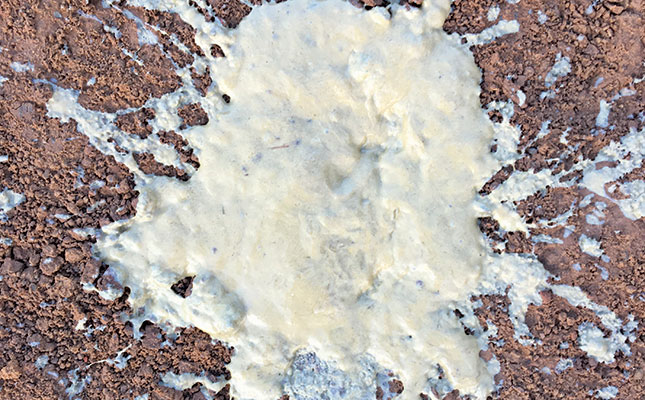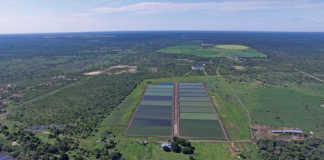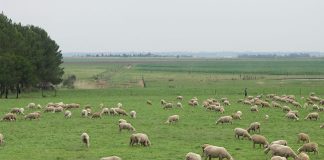
Photo: Dr Liezel Wasserman
Free State-based veterinarian Dr Liezel Wasserman is considered by many to be one of the foremost experts in managing diarrhoea in lambs and calves.
She started building up her expertise on the subject following the appearance of a distinctive yellowish diarrhoea that was causing fatalities in beef cattle calves in the area in which she was practising near Clocolan in the eastern Free State.
The first incidences occurred at the end of 2013, and the following year, Wasserman started receiving similar reports about lambs.
She has since identified the cause as a Cryptosporidium and Escherichia coli disease complex that has spread to various parts of South Africa, and even as far as Botswana.
“To date, my observations have suggested that more than 18 000 lambs and over 7 000 calves have died from this,” she says.
During her quest to identify the disease and determine its origin, she has studied in detail how best to deal with various types of diarrhoea encountered in lambs and calves.
She addressed the topic during her presentation to sheep farmers attending the provincial congress of the National Wool Growers’ Association held in Brandfort in the Free State earlier this year.
The spread of E. Coli
According to Wasserman, there are nearly 900 types of E. coli bacteria in existence.
“Within an hour of birth, every newborn, whether it be a lamb, calf or baby human, will have up to 100 different bacterial colonies living inside its intestinal canal.”
E. coli are able to spread remarkably quickly and, in addition, can build up resistance to antibiotics within days.
She explains that the DNA of the E. coli bacterium is not contained inside a nucleus, but floats freely inside the body of the bacterium. The DNA can be exchanged between living E. coli, but also after the bacteria have died.
“If one bacterium dies, it breaks open and the DNA material is released into the intestinal canal.
Other E. coli that are not yet dead then absorb those parts of that DNA and change their own DNA so that they will not die from the antibiotics a farmer is administering. This is why it’s essential that antibiotics are used responsibly,” she says.
Causes of diarrhoea
Wasserman explains that most of the E. coli bacteria in an animal’s digestive tract are ‘good’ bacteria, yet these are responsible for most diarrhoea cases. This is because they produce both gas and endotoxins if present in the wrong ratio or in the wrong place, and this can prove fatal.
“So the animal dies from diarrhoea, septicaemia or dehydration.”
E. coli can also cause abscesses in the liver and negatively affect the lungs in poor growers, among other ailments.
However, the particular diarrhoea condition that Wasserman has observed over the past seven years is not caused solely by E. coli. Laboratory results have shown that in
80% of cases for which she submitted samples, there was a combination of E. coli and the protozoal organism Cryptosporidium present in the animal’s gut.
She explains that Cryptosporidium reproduce by releasing sporozoites (spore-like stages of its life cycle) in the intestinal canal. There are 26 different species of this genus.
“The important one for us is C. parvum,” she says.
Typically, the animal will ingest a Cryptosporidium oocyte (immature egg cell), which
could be present in the soil or water, or on the shoes or clothes of a handler. The oocyte then locates itself in the lining of the intestine, from where it releases sporozoites into the lumen of the intestinal tract.
These go through further stages in the life cycle and are finally excreted with the faeces again as oocytes.
“Just 10 oocytes are enough to cause diarrhoea in an animal and result in its death within two to three days,” says Wasserman.
Cryptosporidiosis (crypto) is also a zoonosis, meaning that it can be spread from animals to humans.
Wasserman confirms that municipalities in northern parts of KwaZulu-Natal and other provinces test for crypto in water intended for human consumption. It is viewed as deadly to immune-compromised people such as babies, small children and the elderly.
One of the reasons crypto is so dangerous is that it paves the way for opportunistic bacteria to flourish where they would not otherwise pose a risk. In a healthy lamb or calf, E. coli occurs naturally in the hind part of the intestinal canal, which comprises the rectum, colon and large intestine. Normally, only small numbers are found here. However, the site at which crypto attaches itself becomes damaged.
“The E. coli become opportunistic and use the compromised gut lining to enter the body. At this point, an infection can snowball out of control,” she says.
Prevention
According to Wasserman, implementing best-practice biosecurity measures, good management, and a holistic focus on health are critical in addressing all forms of diarrhoea. With this specific disease complex, prevention is particularly important as there is no vaccination against crypto.
Developing an effective vaccine against a protozoan is problematic, Wasserman points out.
“They tried it for tick bite fever in dogs, but the problem is you have to repeat the vaccination every three to four months. It doesn’t work well because the body’s immune system does not remember that immunity for very long.”
Treatment options are also limited, with no registered products to use against crypto in South Africa. At one stage, Wasserman imported a product that was effective, but this requires a permit for a specific client, based on a positive diagnosis of crypto from samples taken at a post-mortem.
It is difficult, costly and time-consuming to obtain the permit and also requires that she submit follow-up reports on its efficacy. In addition, there is currently a worldwide shortage of the product.
Another problem with crypto is its resilience; it can withstand temperatures of between -20°C and 60°C, and the oocytes can survive for decades in soil or water. This makes good biosecurity critical to prevent contamination of the environment in the first place.
Isolate immediately
Wasserman stresses that the farmer’s first action when dealing with diarrhoea should be to immediately isolate any animal suspected of being ill; this includes isolating a lamb from its mother.
Infections can even be spread by flies landing on contaminated faeces.
In addition, farmers and their staff should never work with healthy stock after handling sick animals.
Preventing dehydration is critical. Wasserman advises administering electrolytes, but emphasises that these should be the right type to restore the pH balance. A veterinarian can assist with obtaining electrolytes that are not made from a bicarbonate base.
He or she can also supply products such as kaolin powder to aid with binding the digestive system.
Wasserman also recommends administering a non-steroidal anti-inflammatory. “It helps for the pain, inflammation and fever. Most of these animals will have fever.”
Cortisone should not be used in baby animals, however.
Strengthening the lamb’s immune system
Wasserman’s main recommendation is to ensure that each lamb has a fighting chance even before it is conceived.
A century ago, she explains, a farmer would have been satisfied if a ewe lambed once a year, whereas today a ewe might be expected to lamb three times every two years or even twice a year.
“We need to realise that if we have higher reproductive expectations of our animals, we need to supplement them with vitamins, minerals and micro-elements. These are not all provided for from the veld alone,” she says.
Two other management factors – vaccination and feeding – also play a key role in building up a healthy immune system. A ewe should be given all the necessary vaccines, including vaccination against enzootic abortion, at least once in her life. Ewes should also receive sufficient feed and supplementation so that they are able to produce good-quality colostrum.
Email Dr Liezel Wasserman at [email protected], or phone her on 051 943 0436.










